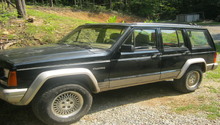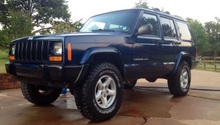Jeep Cherokee 1984-2001: Why is My Frame Squeaking?
Is a squeaky frame driving you crazy? This article will help you track down the source of that squeak and help you retain your sanity!
This article applies to the Jeep Cherokee (1984-2001).
There is nothing more annoying than a squeaky frame. Every time you turn a corner, hit a bump, or drive on an uneven surface, the noise persists. Sure, you can just turn up the radio a little louder and try to ignore it. But why do that when you can simply fix it and enjoy a smooth, quiet ride once again? Tracking down the source of the problem can be a little difficult and time consuming, but we're here to help you narrow things down until you discover the source of your squeak and silence it for good.

Materials Needed
- Floor jack
- Jack stands
- Flashlight
Step 1 – Check the shocks/struts
One of the simplest things to check, and the most common cause of squeaks, is bad shocks. Some of the symptoms of bad shocks include excessive bouncing when you drive over a bump or dip in the road, the nose of your car dives under braking or the rear end squats, "cupping" or "scalloping" wear on your tires, or leaking fluid. To check your shocks, push down on each of the four corners of the car and observe how the car comes back up. If it bounces, the shocks and/or struts are bad.

Step 2 – Check the U-joints
Another common cause of squeaky suspensions are bad U-joints. When they begin to wear out, U-joints cause strange vibrations due to excessive play, which eventually leads to rattling at lower speeds. The problem generally gets worse fairly quickly and the noise and vibrations increase. When turning the wheel, you will also likely hear a clicking noise. You can also check your U-joints by jacking up the car and looking at your drive shaft. Try turning the drive shaft by hand and watch the U-joints. They should rotate with the drive shaft and there should be no excessive play.

Step 3 – Check the suspension bushings
There are a variety of bushings throughout your suspension, and over time they wear out after repeatedly cushioning the many bumps and dips you drive over each day. Bad bushings can make noises including not only a squeak, but also clunks or squeals. Drive over some bumps and turn the wheel, listening for these noises. Also note if the car drifts or pulls to one direction while driving on the highway. Another symptom of bad bushings includes uneven tire wear.
Check the bushings on top of your shocks or struts, as well as at each end of the sway bar and the upper and lower control arms. Check each bushing to see if it is deformed, crushed, flat, cracked, or splitting. Also push down on each suspension component and observe if the bushings separate or split under load.

Step 4 – Check the tie rod ends
Over time, tie rod ends wear out, leading to uneven tire wear, squeaking while turning, and a loose feeling in the steering. Even worse, a broken tie rod end can cause a complete loss of steering. To check your tie rod ends, jack up the front of the vehicle and place it on jack stands so that the front suspension is hanging freely. Push in and out on the front tires and check for any slack in the tie rod ends. If there is slack present, it's time to replace them.

Related Discussions
- Squeaking when Turning - CherokeeForum.com
- Squeaking Passenger Side Only - CherokeeForum.com
- Creaking Noise from Left Front Tire Only - CherokeeForum.com






